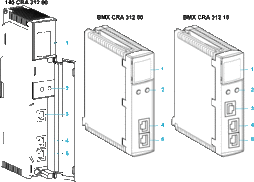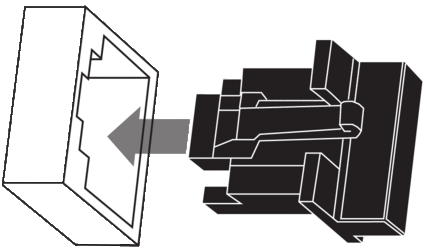Introduction
These adapter modules are used on Ethernet remote I/O drops in 31 Quantum EIO installations:
140CRA31200
BMXCRA312•0
A remote I/O drop can be connected directly to either the main ring or a remote I/O sub-ring.
Functionality
Adapter modules exchange data with the 140CRP31200 remote I/O head module on the local rack:
The 140CRA31200 module is an adapter module on a Quantum remote I/O drop.
The BMXCRA31200 and BMXCRA31210 modules are adapter modules on Modicon X80 remote I/O drops.
Features:
The input data from the Ethernet remote I/O drop is collected and published to the remote I/O scanner.
The output modules are updated with the data received from the remote I/O scanner.
The protocol used for exchange is EtherNet/IP.
The remote I/O scanner views the 140CRA31200 or BMXCRA312•0 module as a remote I/O adapter.
The exchanges are deterministic, which means that the time it takes to resolve a remote I/O logic scan is predictable.
| CAUTION | |
|---|---|
External Features
These adapter modules have the same dimensions and installation constraints as other modules in their respective product lines (Quantum or Modicon X80):

1 LED display
2 rotary switches
3 SERVICE port (ETH 1)
4 DEVICE NETWORK port (ETH 2)
5 DEVICE NETWORK port (ETH 3)
NOTE: To help prevent dust from entering the unused Ethernet ports on these adapter modules, cover the ports with the stopper:

External Ports
Two of the Ethernet ports allow implicit I/O exchanges with a remote I/O scanner adapter. (An implicit I/O exchange has a maximum frame size of 1400 bytes.) The ports can be implemented alone or in redundant mode.
You can use a maximum of 31 adapters in a single Ethernet remote I/O network. For network topology planning, refer to the Quantum Ethernet I/O System Planning Guide.
These modules have up to three 10/100 Base-T Ethernet ports:
Port |
Description |
|---|---|
SERVICE |
The SERVICE port allows the diagnosis of Ethernet ports and provides access to external tools and devices (Control Expert, ConneXium Network Manager, HMI, etc.). The port supports these modes:
NOTE:
Refer to Service Port Configuration. |
DEVICE NETWORK |
The DEVICE NETWORK copper port provides:
|
Cable Redundancy
Use a daisy chain network configuration that implements the RSTP service to establish redundant communications between the adapter module and a remote I/O scanner. The adapter operates normally when at least one of the 2 physical paths to the 140CRP31200 is valid. (For network topology planning, refer to the Quantum Ethernet I/O System Planning Guide.)


